JB/T 6316-1992
基本信息
标准号: JB/T 6316-1992
中文名称:Z4系列直流电动机技术条件 (机座号100~355)
标准类别:机械行业标准(JB)
英文名称: Technical Specifications for Z4 Series DC Motors (Frame Size 100 to 355)
标准状态:已作废
发布日期:1992-06-26
实施日期:1993-01-01
作废日期:2007-04-01
出版语种:简体中文
下载格式:.rar.pdf
下载大小:34225200
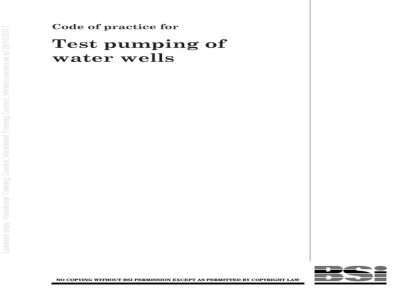
标准分类号
中标分类号:电工>>旋转电机>>K23直流电机
出版信息
出版社:机械工业出版社
页数:18 页
标准价格:18.0 元
出版日期:1993-01-01
相关单位信息
标准简介
JB/T 6316-1992 Z4系列直流电动机技术条件 (机座号100~355) JB/T6316-1992 标准下载解压密码:www.bzxz.net
标准图片预览
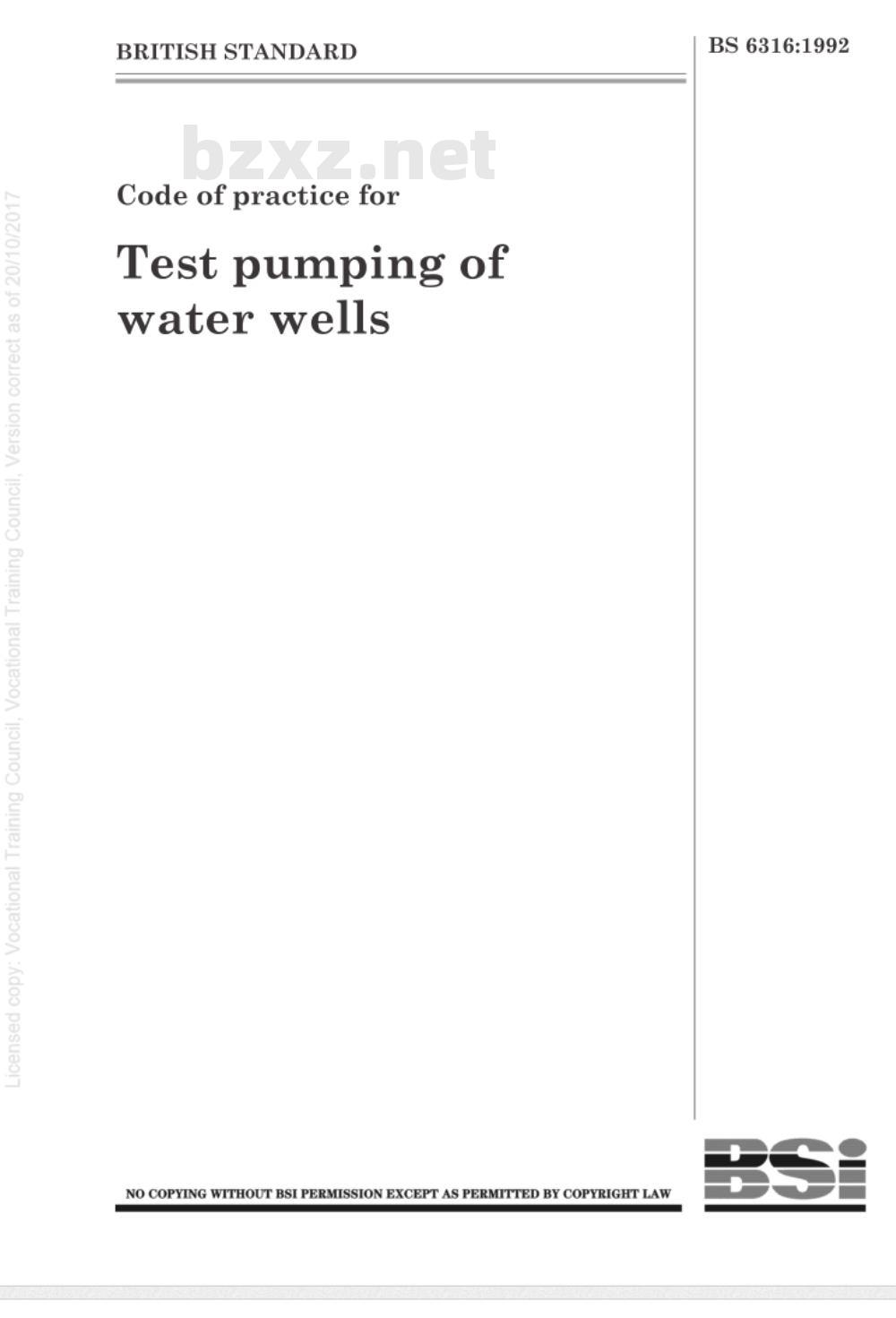
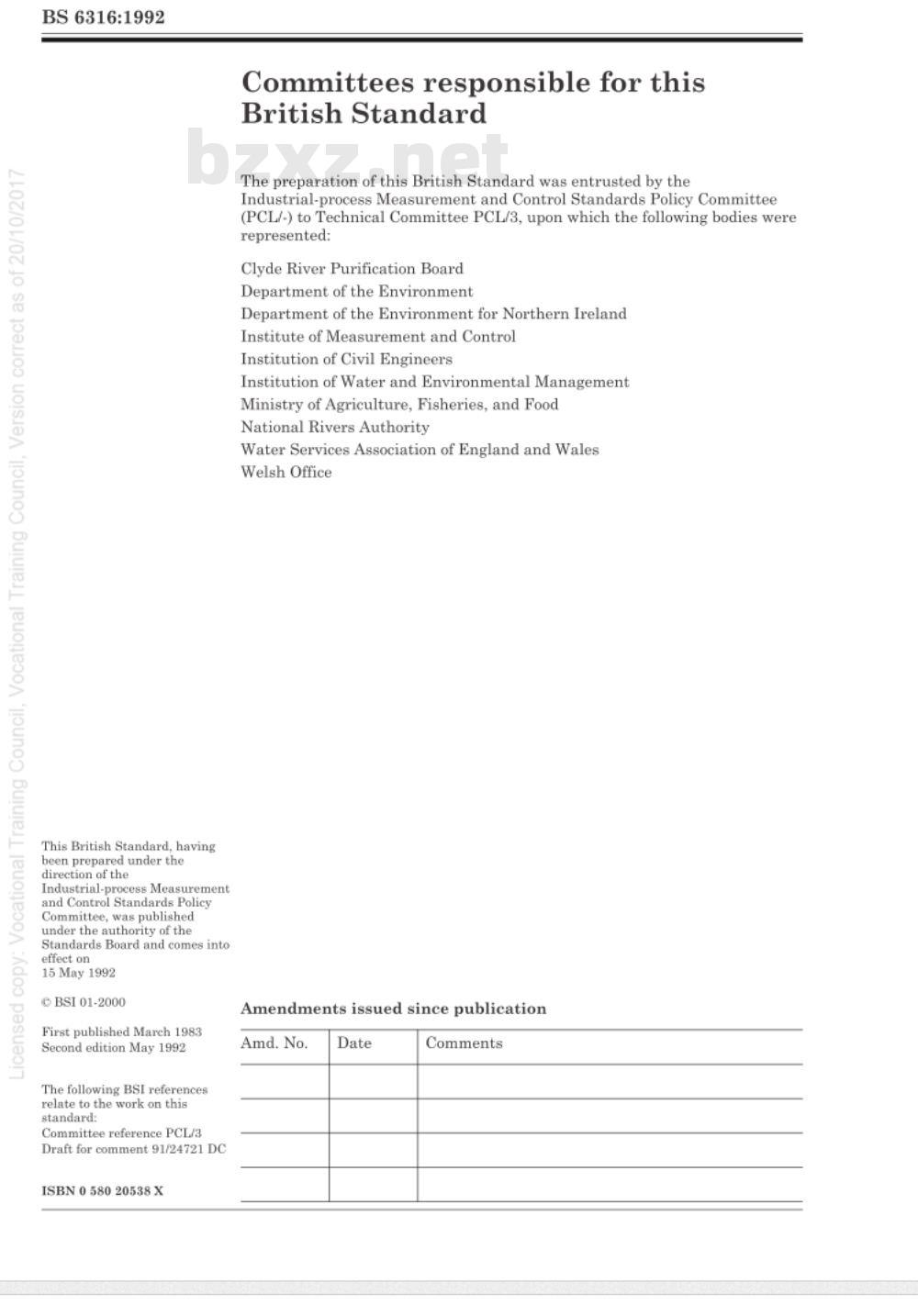
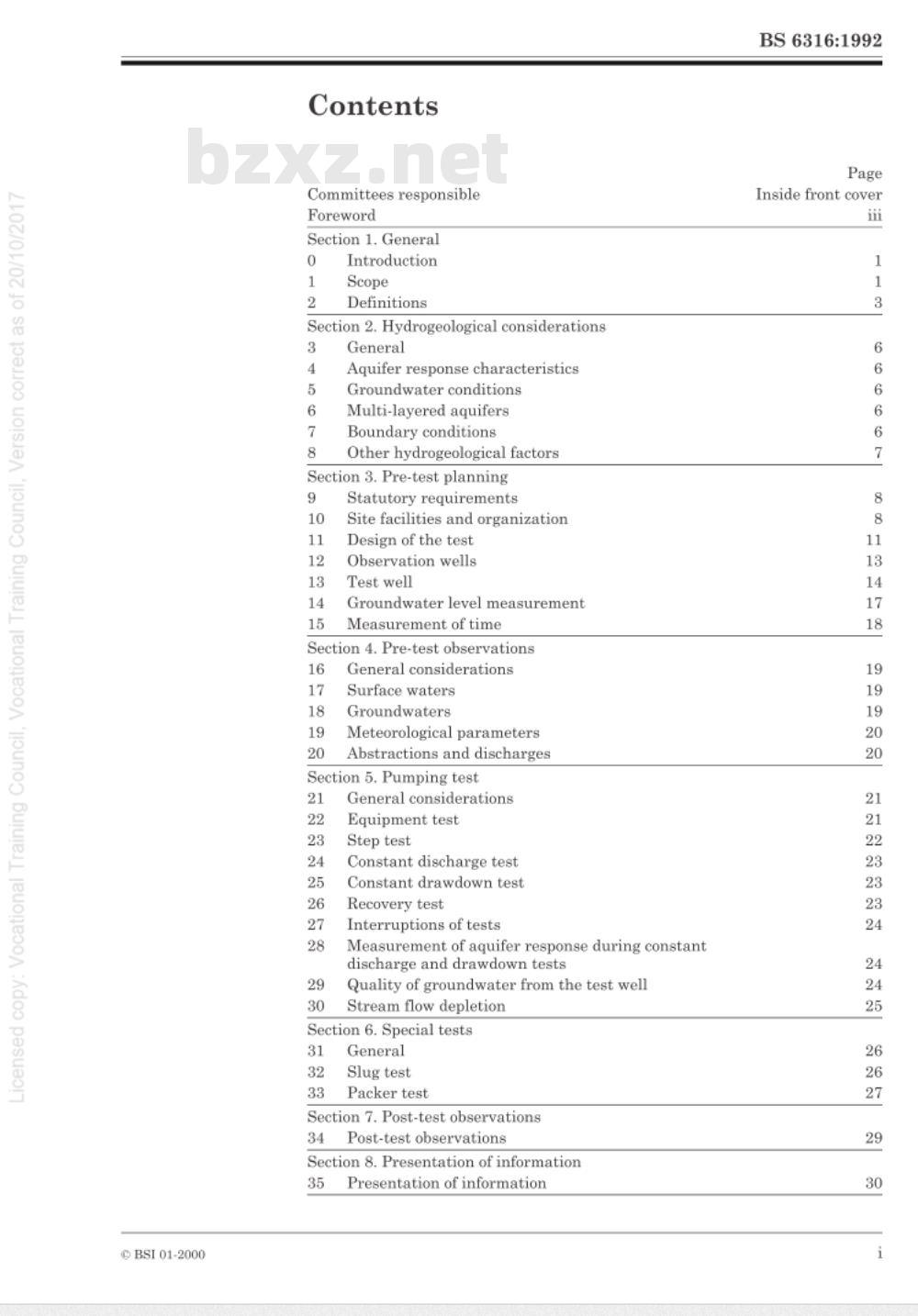
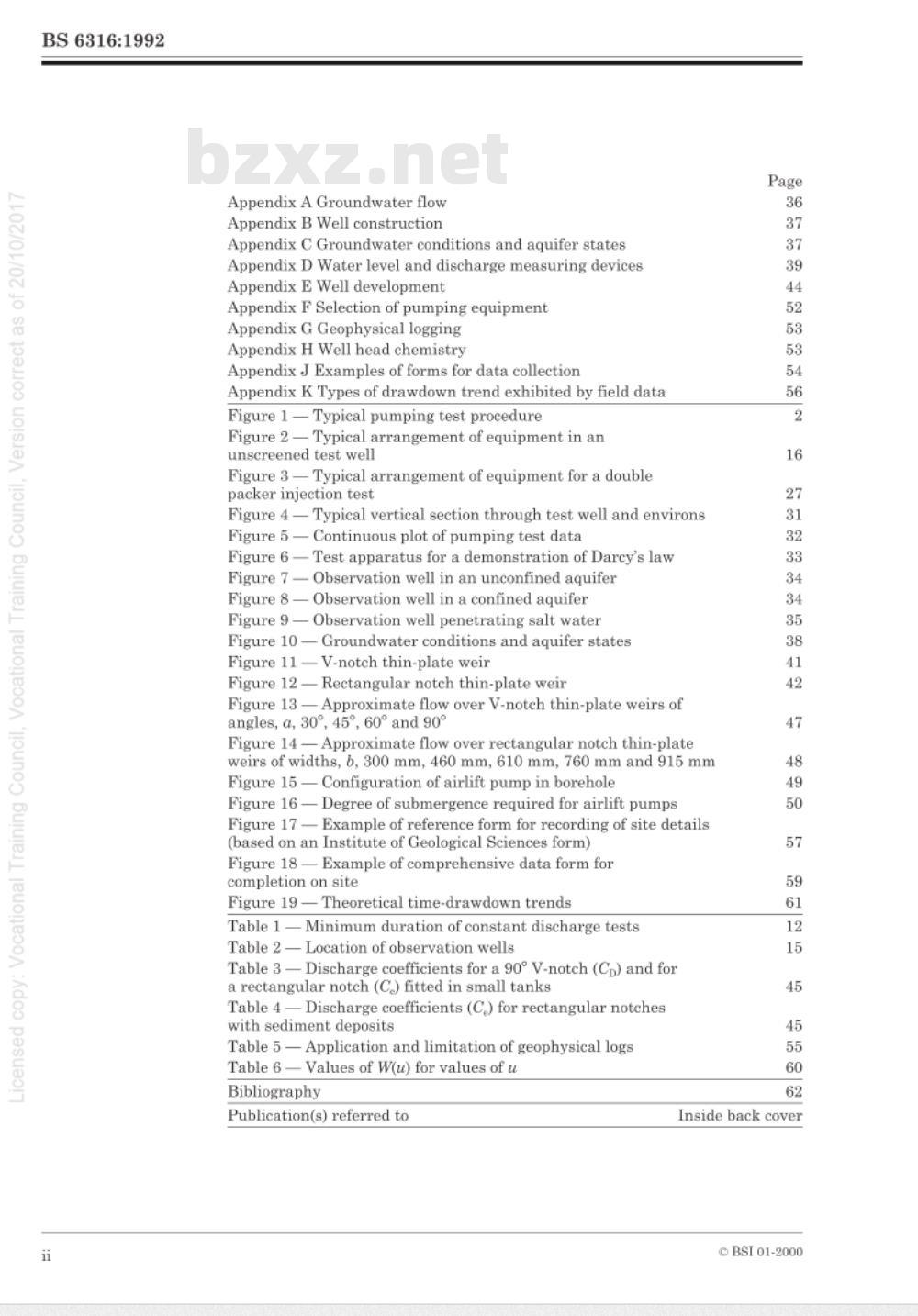
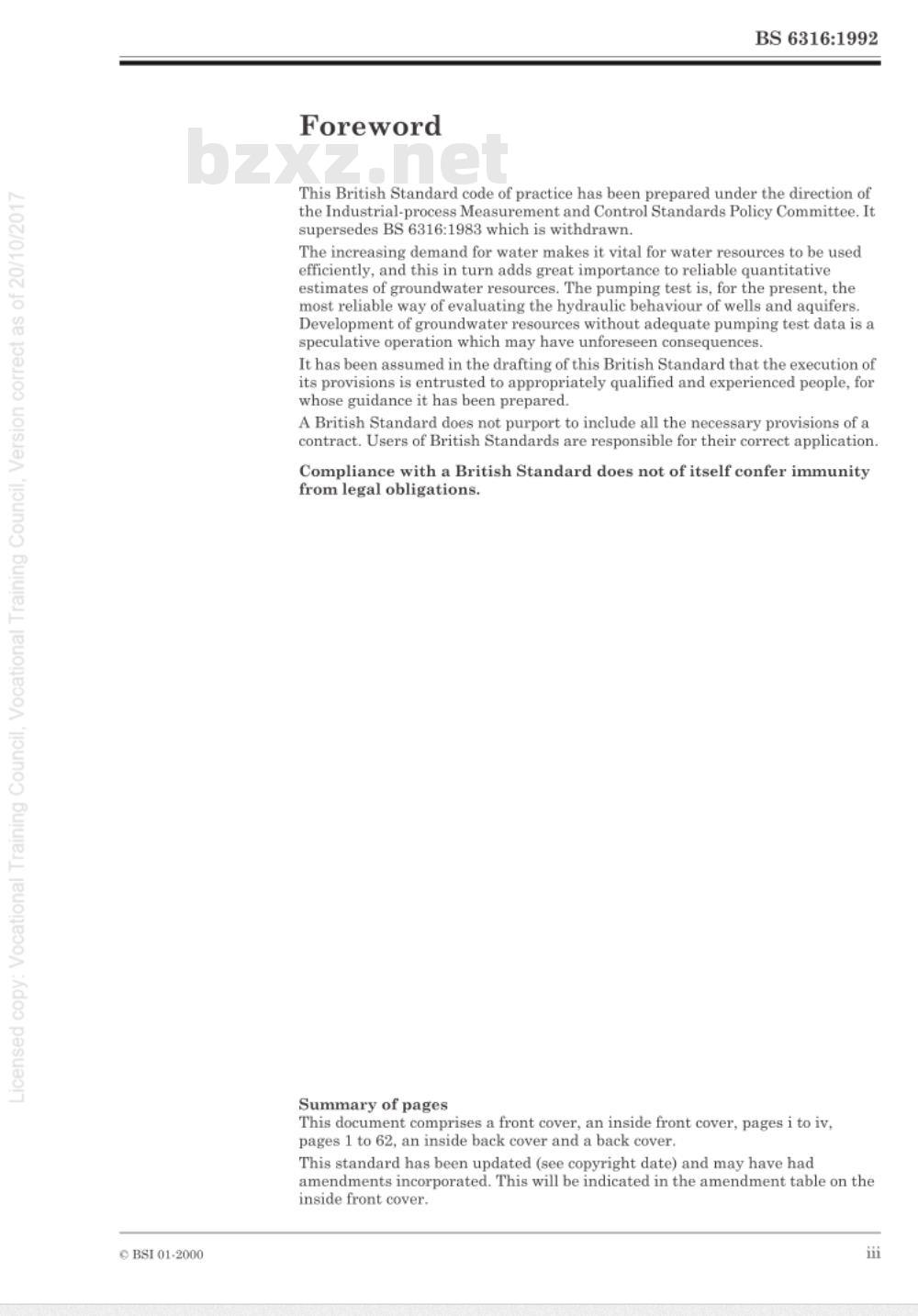
标准内容
oaoseeeoo
BRITISH STANDARD
Code of practice for
Test pumping of
water wells
NOCOPYINGWITHOUTBSIPERMISSIONEXCEPTASPERMITTEDBYCOPYRIGHTLAWBS6316:1992
BS6316:1992
This British Standard, havingbeen prepared under the
direction of the
Industrial-process Measurementand Control Standards PolicyCommittee, was published
under the authority of the
Standards Board and comes intoeffect on
15May1992
CBSI 01-2000
First published March 1983
Second edition May 1992
The following BSI referencesrelate to the work on this
standard:
Committee reference PCL/3
Draft for comment 91/24721 DCISBN058020538X
Committees responsible for thisBritish Standard
Thepreparation of thisBritishStandardwas entrustedbytheIndustrial-process Measurement and Control Standards Policy Committee(PCL/-) to Technical Committee PCL/3, upon which the following bodies wererepresented:
Clyde River Purification BoardDepartmentoftheEnvironment
DepartmentoftheEnvironmentforNorthernIrelandInstituteof Measurementand ControlInstitutionof CivilEngineersInstitutionofWaterandEnvironmentalManagementMinistry of Agriculture, Fisheries, and FoodNational Rivers Authority
WaterServicesAssociationofEnglandandWalesWelshOffice
Amendments issued sincepublicationAmd.No.
Comments
BSI01-2000
Contents
Committeesresponsible
Foreword
Section 1. General
Introduction
Definitions
Section2.Hydrogeological considerationsGeneral
Aquifer response characteristics5
Groundwater conditions
Multi-layered aquifers
Boundary conditions
Other hydrogeological factorsSection 3. Pre-test planning9
Statutory requirements
SitefacilitiesandorganizationDesign of the test
Observation wells
Test well
Groundwater level measurementMeasurement of time
Section 4. Pre-test observations16
General considerations
Surface waters
Groundwaters
Meteorological parameters
Abstractions and discharges
Section 5.Pumping test
General considerations
Equipment test
Step test
Constant discharge test
Constant drawdown test
Recovery test
Interruptions of tests
Measurement of aquifer response during constantdischarge and drawdown testsQuality ofgroundwaterfromthetestwellStream flow depletion
Section 6. Special tests
General
Slug test
Packertest
Section7.Post-testobservations34
Post-test observations
Section8.Presentationofinformation35
Presentation of information
BS6316:1992
Inside front cover
BS6316:1992
AppendixAGroundwaterflow
Appendix B Well constructionAppendix C Groundwater conditions and aquifer statesAppendixD Water level and dischargemeasuring devicesAppendixEWelldevelopment
AppendixF Selection of pumping equipmentAppendix GGeophysical loggingAppendixHWell head chemistryAppendixJExamples offormsfor data collectionAppendix K Types of drawdown trend exhibited by field dataFigure1-Typical pumpingtestprocedureFigure2-Typical arrangement of equipment in anunscreened testwell
Figure3-Typical arrangement of equipment for a doublepackerinjectiontest
Figure 4-Typical vertical section through test well and environsFigure5Continuousplot of pumping testdataFigure 6Test apparatus for a demonstration of Darcy's lawFigure 7-Observation well in an unconfined aquiferFigure 8-Observation well in a confined aquiferFigure 9Observation well penetrating salt waterFigure 10 Groundwater conditions and aquifer statesFigure 11-V-notch thin-plate weirFigure 12—Rectangular notch thin-plate weirFigure13Approximate flow over V-notch thin-plate weirs ofangles,a,30°45°60°and90°Figure 14-Approximateflow over rectangular notch thin-plateweirsofwidths,b,300mm,460mm,610mm,760mmand915mmFigure15-Configuration of airlift pump in boreholeFigure16-—Degree of submergence required for airlift pumpsFigure17-Example of reference form forrecording of site details(based on an Institute of Geological Sciences form)Figure18Example of comprehensivedata formforcompletiononsite
Figure 19—Theoretical time-drawdown trendsTable1—Minimumdurationof constantdischargetestsTable2-Locationof observationwellsTable 3—Discharge coefficients for a 90° V-notch (Cp) and fora rectangular notch (C)fitted in small tanksTable 4Discharge coefficients (C) for rectangular notcheswith sedimentdeposits
Table 5-Application and limitation of geophysical logsTable6—Values of W(u)for values ofuBibliography
Publication(s) referred to
Inside back cover
C BSI 01-2000
aeeeeeee
BSI01-2000
Foreword
BS6316:1992
This British Standard code of practice has been prepared under the direction ofthe Industrial-process Measurement and Control Standards Policy Committee. ItsupersedesBS6316:1983whichiswithdrawnThe increasing demand for water makes it vital for water resources tobeusedefficiently, and this in turn adds great importance to reliable quantitativeestimates of groundwater resources. The pumping test is, for the present, themost reliable way of evaluating the hydraulic behaviour of wells and aquifers.Development of groundwater resources without adequate pumping test data is aspeculative operation which may have unforeseen consequences.It has been assumed in the drafting of this British Standard that the execution ofits provisions is entrusted to appropriately qualified and experienced people, forwhoseguidanceit has beenprepared.A British Standard does not purport to include all the necessary provisions of acontract.Users of British Standards are responsible for their correct application.Compliance with a British Standard does not of itself confer immunityfromlegalobligations.
Summary of pages
This document comprises a front cover, an inside front cover, pages i to iv,pages1to62,an insidebackcoverandaback cover.This standard has been updated (see copyright date) and may have hadamendments incorporated. This will be indicated in the amendment table on theinside front cover.
Section 1. General
0Introduction免费标准bzxz.net
Pumping tests are normally carried out to obtaindata with which to:
a) assess the hydraulic behaviour of a well and sodetermine its ability to yield water, predict itsperformance under different pumping regimes,select the most suitable pumping plant for longterm use and give some estimate of probablepumping costs;
b) determine the hydraulic properties of theaquifer or aquifers which yield water to the well;these properties include the transmissivity andrelated hydraulic conductivities, storagecoefficient and the presence, type and distance ofany hydraulic boundaries;
c) determine the effects of pumping uponneighbouring wells, watercourses, or springdischarges.
Apumping test also provides a good opportunity toobtain information on water quality and itsvariation with time and perhaps with dischargerate.
Whenwaterispumped from awell,theheadinthewell is lowered, creating a drawdown or head lossand setting up a localized hydraulic gradient whichcauses water to flow to the well from thesurrounding aquifer. The head in the aquifer is alsoreduced and the effect spreads outwards from thewell. A cone of depression of the potentiometricsurface is thus formed around the well and theshape and the manner of expansion of this conedepend on the pumping rate and on the hydraulicproperties of the aquifer. By recording the changesin the position of the potentiometric surface inobservation wells located around the pumping wellit is possible to monitor the growth of the cone ofdepression and determine these hydrauliccharacteristics. The form of the cone of depressionimmediately around the well will generally bemodified because additional head losses areincurred as the water crosses the well face. Thedrawdown may be considered to consist of twocomponents:
1) head loss through the aquifer;2)headloss inthewell.
Consequently, there are two test objectives: anunderstanding of the characteristics of the well andthoseoftheaquifer.
A test may be performed to serve any or all of themain objectives. If they are satisfied it may be saidthat the hydraulic regime of the well and aquiferhas been evaluated. However it needs to beunderstood that other information, particularlyabout other factors affecting recharge, will berequired to predict the long term effects ofabstraction.
BSI01-2000
BS6316:1992
It needs to be recognized that there are inherentdifficulties involved in carrying out a pumping test,e.g. making many physical measurements. In partthese arise from the tendency of the measuringprocess or equipment to change the quantity beingmeasured. For example, the drilling of boreholes toinvestigate the hydraulic regime of an aquifer maydisturb that hydraulic regime by providing verticalcommunication between aquifer levels containingwater at differentheads.A second difficulty involvessampling. Only rarely will a cone of depression becircular and symmetrical; the relatively fewobservation boreholes which are usually availableineffectprovidea limited number of sampling pointswith which to determine the form of the cone. It isimportant that these limitations and difficulties arekept clearly in mind when designing and analysinga pumping test and, in particular, when using theresults.
Figure 1 indicates the normal sequence of events ina pumping test.
1Scope
This code of practice describes the factors whichneed to be considered and the measurements whichneed to be made when designing and performing apumping test. However, there can be no such thingas a“standard\ pumping test because of the greatdiversity of objectives, aquifers, groundwaterconditions, available technology and legal contexts.This code therefore provides a set of guidelines forfieldpractice,withanindicationofhowtheymaybevaried to take account ofparticularlocal conditions.It deals with the usual types of pumping testscarried out for water supply purposes, in whichwater is abstracted from the entire screened,perforated, or unlined interval(s) of a well, Someguidance is also provided on slug tests and packertests. Specialized tests, such as drill-stemtests, andtests of stratafor engineering purposes, are notconsidered in detail. Guidance on some of thesespecialized tests is given in BS 5930.Interpretation of the data collected during apumping test is referred to in this code only in ageneral way. For full details of the analysis andinterpretation of test data, e.g. with regard tostream flow depletion, reference should be made tospecialized texts. Examples of such texts areincluded in a selected bibliography.NOTEThe titles of the publications referred to in this code ofpractice are listed on the inside back cover.1
O BSI 01-2000
2Definitions
Test superisior
Figure 1 Typical pumping test procedure2.10
confiningbed
For the purposes of this British Standard thefollowingdefinitionsapply.
abstraction
theremoval ofwaterfrom any source, eitherpermanentlyortemporarily
access tube
a pipe inserted into a well to permit installation ofinstruments, and safeguarding themfromtouchingorbecoming entangled with thepump or otherequipment in the well
aquifer
a lithologicalunit,group oflithological units,orpartof alithologicalunitcontainingsufficientsaturatedpermeable material to yield significant quantities ofwatertowellsorsprings
NOTE It may contain unsaturated permeable material.2.4
aquiferloss
thehead loss at apumped or overflowing wellrah
B 6161992
BS6316:1992
a bed or body of impermeable materialstratigraphically adjacent to an aquifer andrestricting or reducingnatural flow of groundwaterto or from the aquifer
discharge
volumetric flowrate
drawdown
the reduction in static head within the aquiferresultingfromabstraction
See also Appendix A.
filterpack
granular material introduced into a well betweenthe aquifer and a screen or perforated lining toprevent or control the movement of particles fromtheaquifer intothewell
steadyflow
flowin whichparameters suchasvelocity,pressureeeee
2Definitions
For the purposes of this British Standard thefollowingdefinitionsapply
abstraction
the removal ofwaterfrom any source, eitherpermanently or temporarily
access tube
a pipe inserted into a well to permit installation ofinstruments, and safeguarding them from touchingor becoming entangled with the pump or otherequipment in the well
aquifer
a lithological unit,group oflithological units, orpartof a lithological unit containing sufficient saturatedpermeablematerialtoyieldsignificantquantitiesofwatertowells orsprings
It may contain unsaturated permeable material.2.4
aquiferloss
the head loss at a pumped or overflowing wellassociated with groundwater flow through theaquifer to the well face
aquifer properties
the properties of an aquifer that determine itshydraulic behaviour and its response to abstraction2.6
borehole
a hole, usually vertical, bored to determine groundconditions, for extraction of water or measurementofgroundwaterlevel
casing
a tube used as temporary or permanent lining for awell
columnpipe
that part of the rising main within the well2.9
cone of depression
that portion of the potentiometric surface that isperceptibly lowered as a result of abstraction ofgroundwater from a well
BSI01-2000
confiningbed
BS6316:1992
abed orbody ofimpermeablematerialstratigraphically adjacent to an aquifer andrestricting or reducing natural flow of groundwaterto or from the aquifer
discharge
volumetric flow rate
drawdown
the reduction in static head within the aquiferresultingfromabstraction
NOTE See also Appendix A.
filterpack
granular material introduced into a well betweenthe aquifer and a screen or perforated lining toprevent or control themovement ofparticles fromthe aquifer into the well
steadyflow
flow in which parameters such as velocity,pressuredensity, and temperature do not vary sufficientlywith time to affect the required accuracy ofmeasurement
uniformflow
flowin which themagnitude and direction offlow ata given moment are constant with respect todistance
footvalve
a non-return valve fitted at the bottom of a suctionpipe of a pump
groundwater
waterwithin saturation zone
hydraulic conductivity
the volume of water at the existing kinematicviscosity that will move in unit time under a unithydraulic gradient through a unit area measuredperpendicular to the direction of flowSee also Appendix A.
This definition assumes an isotropic medium in whichNOTE2
the pores are completely filled with water.2.19
hydraulic gradient
the change in static head per unit of distance in agiven direction
BS6316:1992
hydrogeology
the study of subsurface water in its geologicalcontext
impermeablematerial
material that does not permit water to movethrough it at perceptible rates under the hydraulicgradientsnormallypresent
incompetentstratum
a stratum unable to stand without support2.23
isotropic
having the same properties in all directions2.24
lining
a tube or wall used to support the sides of a well, andsometimes to prevent the entry of water2.25
liningtube
a preformed tube used as the lining for a wellNOTE
, See also casing (defined in 2.7) and screen(defined in 2.38).
lithology
the physical character and mineralogicalcomposition that gives rise to the appearance andproperties of a rock
observationwell
a well used for observing groundwater head orquality
overflowingwell
a well from which groundwater is discharged at theground surface without the aid of pumpingNOTE
A deprecated term for this definition is an artesian well.2.29
permeability
the characteristic of a material that determines therate at which fluids pass through it under theinfluence of differential pressure2.30
permeable material
material that permits water to move through it atperceptible rates under the hydraulic gradientsnormally present
phreatic surface
the upper boundary of an unconfined groundwaterbody, at which the water pressure is equal toatmospheric
potentiometric surface
the surface that represents the static head ofgroundwater
radius of influence
the radius of the cone of depression2.34
risingmain
the pipe carrying waterfrom within a well to a pointofdischarge
a natural mass of one or more minerals that may beconsolidated or loose (excluding top soil)2.36
running plot
a graph of a variable against elapsed timecontinually updated as measurements are taken2.37
saturated zone
that part of an aquifer, normally beneath thedeepest water table, in which ideally all voids arefilled with water under pressure greater thanatmospheric
screen
a type of lining tube, with apertures designed topermit the flow of water into a well while preventingthe entry of aquifer or filter pack material2.39
slurry
the mixture of fluid and rock fragments formedwhen drilling or developing a borehole2.40
specific capacity
the rate of discharge of water from the well dividedby the drawdown within the well2.41
specific yield
the ratio of the volume of water yielded by unitvolume of permeable rock or soil when drained bygravity under specified conditions after beingsaturated tounitvolume
CBSI 01-2000
static head
theheight,relativetoanarbitraryreferencelevel,ofa column of water that can be supported by thestatic pressure at a given point2.43
storage coefficient
the ratio of the volume of water that a verticalcolumn of an aquifer of unit cross-sectional areareleases from storage as the head within the columndeclines unit distance to unit volume2.44
transmissivity
the rate at which water of the prevailing kinematicviscosity is transmitted through a unit width of thesaturatedaquiferunderaunithydraulicgradient2.45
unconsolidated rock
rockthatlacksnatural cementation2.46
unsaturated zone
that part of an aquifer between the land surface andthedeepestwatertable
viscosity
the property of a fluid whereby it tends, withinitself, to resist relative motionSee also Appendix A.
BSI01-2000
watertable
BS6316:1992
the surface of a groundwater body at which thewater pressure is atmospheric2.49
a hole sunk into the ground for abstraction of waterorforobservationpurposes
See also Appendix B.
well development
the physical and chemical treatment of a well toachieveminimumresistancetomovementofwaterbetweenwellandaquifer
well efficiency
a measure of the performance of a production well2.52
well loss
the head loss resulting from flow of groundwateracross the well face, including any part of theaquifer affected by drilling, and any filter pack orlining tube, into the well and up or down the well tothepump
小提示:此标准内容仅展示完整标准里的部分截取内容,若需要完整标准请到上方自行免费下载完整标准文档。
BRITISH STANDARD
Code of practice for
Test pumping of
water wells
NOCOPYINGWITHOUTBSIPERMISSIONEXCEPTASPERMITTEDBYCOPYRIGHTLAWBS6316:1992
BS6316:1992
This British Standard, havingbeen prepared under the
direction of the
Industrial-process Measurementand Control Standards PolicyCommittee, was published
under the authority of the
Standards Board and comes intoeffect on
15May1992
CBSI 01-2000
First published March 1983
Second edition May 1992
The following BSI referencesrelate to the work on this
standard:
Committee reference PCL/3
Draft for comment 91/24721 DCISBN058020538X
Committees responsible for thisBritish Standard
Thepreparation of thisBritishStandardwas entrustedbytheIndustrial-process Measurement and Control Standards Policy Committee(PCL/-) to Technical Committee PCL/3, upon which the following bodies wererepresented:
Clyde River Purification BoardDepartmentoftheEnvironment
DepartmentoftheEnvironmentforNorthernIrelandInstituteof Measurementand ControlInstitutionof CivilEngineersInstitutionofWaterandEnvironmentalManagementMinistry of Agriculture, Fisheries, and FoodNational Rivers Authority
WaterServicesAssociationofEnglandandWalesWelshOffice
Amendments issued sincepublicationAmd.No.
Comments
BSI01-2000
Contents
Committeesresponsible
Foreword
Section 1. General
Introduction
Definitions
Section2.Hydrogeological considerationsGeneral
Aquifer response characteristics5
Groundwater conditions
Multi-layered aquifers
Boundary conditions
Other hydrogeological factorsSection 3. Pre-test planning9
Statutory requirements
SitefacilitiesandorganizationDesign of the test
Observation wells
Test well
Groundwater level measurementMeasurement of time
Section 4. Pre-test observations16
General considerations
Surface waters
Groundwaters
Meteorological parameters
Abstractions and discharges
Section 5.Pumping test
General considerations
Equipment test
Step test
Constant discharge test
Constant drawdown test
Recovery test
Interruptions of tests
Measurement of aquifer response during constantdischarge and drawdown testsQuality ofgroundwaterfromthetestwellStream flow depletion
Section 6. Special tests
General
Slug test
Packertest
Section7.Post-testobservations34
Post-test observations
Section8.Presentationofinformation35
Presentation of information
BS6316:1992
Inside front cover
BS6316:1992
AppendixAGroundwaterflow
Appendix B Well constructionAppendix C Groundwater conditions and aquifer statesAppendixD Water level and dischargemeasuring devicesAppendixEWelldevelopment
AppendixF Selection of pumping equipmentAppendix GGeophysical loggingAppendixHWell head chemistryAppendixJExamples offormsfor data collectionAppendix K Types of drawdown trend exhibited by field dataFigure1-Typical pumpingtestprocedureFigure2-Typical arrangement of equipment in anunscreened testwell
Figure3-Typical arrangement of equipment for a doublepackerinjectiontest
Figure 4-Typical vertical section through test well and environsFigure5Continuousplot of pumping testdataFigure 6Test apparatus for a demonstration of Darcy's lawFigure 7-Observation well in an unconfined aquiferFigure 8-Observation well in a confined aquiferFigure 9Observation well penetrating salt waterFigure 10 Groundwater conditions and aquifer statesFigure 11-V-notch thin-plate weirFigure 12—Rectangular notch thin-plate weirFigure13Approximate flow over V-notch thin-plate weirs ofangles,a,30°45°60°and90°Figure 14-Approximateflow over rectangular notch thin-plateweirsofwidths,b,300mm,460mm,610mm,760mmand915mmFigure15-Configuration of airlift pump in boreholeFigure16-—Degree of submergence required for airlift pumpsFigure17-Example of reference form forrecording of site details(based on an Institute of Geological Sciences form)Figure18Example of comprehensivedata formforcompletiononsite
Figure 19—Theoretical time-drawdown trendsTable1—Minimumdurationof constantdischargetestsTable2-Locationof observationwellsTable 3—Discharge coefficients for a 90° V-notch (Cp) and fora rectangular notch (C)fitted in small tanksTable 4Discharge coefficients (C) for rectangular notcheswith sedimentdeposits
Table 5-Application and limitation of geophysical logsTable6—Values of W(u)for values ofuBibliography
Publication(s) referred to
Inside back cover
C BSI 01-2000
aeeeeeee
BSI01-2000
Foreword
BS6316:1992
This British Standard code of practice has been prepared under the direction ofthe Industrial-process Measurement and Control Standards Policy Committee. ItsupersedesBS6316:1983whichiswithdrawnThe increasing demand for water makes it vital for water resources tobeusedefficiently, and this in turn adds great importance to reliable quantitativeestimates of groundwater resources. The pumping test is, for the present, themost reliable way of evaluating the hydraulic behaviour of wells and aquifers.Development of groundwater resources without adequate pumping test data is aspeculative operation which may have unforeseen consequences.It has been assumed in the drafting of this British Standard that the execution ofits provisions is entrusted to appropriately qualified and experienced people, forwhoseguidanceit has beenprepared.A British Standard does not purport to include all the necessary provisions of acontract.Users of British Standards are responsible for their correct application.Compliance with a British Standard does not of itself confer immunityfromlegalobligations.
Summary of pages
This document comprises a front cover, an inside front cover, pages i to iv,pages1to62,an insidebackcoverandaback cover.This standard has been updated (see copyright date) and may have hadamendments incorporated. This will be indicated in the amendment table on theinside front cover.
Section 1. General
0Introduction免费标准bzxz.net
Pumping tests are normally carried out to obtaindata with which to:
a) assess the hydraulic behaviour of a well and sodetermine its ability to yield water, predict itsperformance under different pumping regimes,select the most suitable pumping plant for longterm use and give some estimate of probablepumping costs;
b) determine the hydraulic properties of theaquifer or aquifers which yield water to the well;these properties include the transmissivity andrelated hydraulic conductivities, storagecoefficient and the presence, type and distance ofany hydraulic boundaries;
c) determine the effects of pumping uponneighbouring wells, watercourses, or springdischarges.
Apumping test also provides a good opportunity toobtain information on water quality and itsvariation with time and perhaps with dischargerate.
Whenwaterispumped from awell,theheadinthewell is lowered, creating a drawdown or head lossand setting up a localized hydraulic gradient whichcauses water to flow to the well from thesurrounding aquifer. The head in the aquifer is alsoreduced and the effect spreads outwards from thewell. A cone of depression of the potentiometricsurface is thus formed around the well and theshape and the manner of expansion of this conedepend on the pumping rate and on the hydraulicproperties of the aquifer. By recording the changesin the position of the potentiometric surface inobservation wells located around the pumping wellit is possible to monitor the growth of the cone ofdepression and determine these hydrauliccharacteristics. The form of the cone of depressionimmediately around the well will generally bemodified because additional head losses areincurred as the water crosses the well face. Thedrawdown may be considered to consist of twocomponents:
1) head loss through the aquifer;2)headloss inthewell.
Consequently, there are two test objectives: anunderstanding of the characteristics of the well andthoseoftheaquifer.
A test may be performed to serve any or all of themain objectives. If they are satisfied it may be saidthat the hydraulic regime of the well and aquiferhas been evaluated. However it needs to beunderstood that other information, particularlyabout other factors affecting recharge, will berequired to predict the long term effects ofabstraction.
BSI01-2000
BS6316:1992
It needs to be recognized that there are inherentdifficulties involved in carrying out a pumping test,e.g. making many physical measurements. In partthese arise from the tendency of the measuringprocess or equipment to change the quantity beingmeasured. For example, the drilling of boreholes toinvestigate the hydraulic regime of an aquifer maydisturb that hydraulic regime by providing verticalcommunication between aquifer levels containingwater at differentheads.A second difficulty involvessampling. Only rarely will a cone of depression becircular and symmetrical; the relatively fewobservation boreholes which are usually availableineffectprovidea limited number of sampling pointswith which to determine the form of the cone. It isimportant that these limitations and difficulties arekept clearly in mind when designing and analysinga pumping test and, in particular, when using theresults.
Figure 1 indicates the normal sequence of events ina pumping test.
1Scope
This code of practice describes the factors whichneed to be considered and the measurements whichneed to be made when designing and performing apumping test. However, there can be no such thingas a“standard\ pumping test because of the greatdiversity of objectives, aquifers, groundwaterconditions, available technology and legal contexts.This code therefore provides a set of guidelines forfieldpractice,withanindicationofhowtheymaybevaried to take account ofparticularlocal conditions.It deals with the usual types of pumping testscarried out for water supply purposes, in whichwater is abstracted from the entire screened,perforated, or unlined interval(s) of a well, Someguidance is also provided on slug tests and packertests. Specialized tests, such as drill-stemtests, andtests of stratafor engineering purposes, are notconsidered in detail. Guidance on some of thesespecialized tests is given in BS 5930.Interpretation of the data collected during apumping test is referred to in this code only in ageneral way. For full details of the analysis andinterpretation of test data, e.g. with regard tostream flow depletion, reference should be made tospecialized texts. Examples of such texts areincluded in a selected bibliography.NOTEThe titles of the publications referred to in this code ofpractice are listed on the inside back cover.1
O BSI 01-2000
2Definitions
Test superisior
Figure 1 Typical pumping test procedure2.10
confiningbed
For the purposes of this British Standard thefollowingdefinitionsapply.
abstraction
theremoval ofwaterfrom any source, eitherpermanentlyortemporarily
access tube
a pipe inserted into a well to permit installation ofinstruments, and safeguarding themfromtouchingorbecoming entangled with thepump or otherequipment in the well
aquifer
a lithologicalunit,group oflithological units,orpartof alithologicalunitcontainingsufficientsaturatedpermeable material to yield significant quantities ofwatertowellsorsprings
NOTE It may contain unsaturated permeable material.2.4
aquiferloss
thehead loss at apumped or overflowing wellrah
B 6161992
BS6316:1992
a bed or body of impermeable materialstratigraphically adjacent to an aquifer andrestricting or reducingnatural flow of groundwaterto or from the aquifer
discharge
volumetric flowrate
drawdown
the reduction in static head within the aquiferresultingfromabstraction
See also Appendix A.
filterpack
granular material introduced into a well betweenthe aquifer and a screen or perforated lining toprevent or control the movement of particles fromtheaquifer intothewell
steadyflow
flowin whichparameters suchasvelocity,pressureeeee
2Definitions
For the purposes of this British Standard thefollowingdefinitionsapply
abstraction
the removal ofwaterfrom any source, eitherpermanently or temporarily
access tube
a pipe inserted into a well to permit installation ofinstruments, and safeguarding them from touchingor becoming entangled with the pump or otherequipment in the well
aquifer
a lithological unit,group oflithological units, orpartof a lithological unit containing sufficient saturatedpermeablematerialtoyieldsignificantquantitiesofwatertowells orsprings
It may contain unsaturated permeable material.2.4
aquiferloss
the head loss at a pumped or overflowing wellassociated with groundwater flow through theaquifer to the well face
aquifer properties
the properties of an aquifer that determine itshydraulic behaviour and its response to abstraction2.6
borehole
a hole, usually vertical, bored to determine groundconditions, for extraction of water or measurementofgroundwaterlevel
casing
a tube used as temporary or permanent lining for awell
columnpipe
that part of the rising main within the well2.9
cone of depression
that portion of the potentiometric surface that isperceptibly lowered as a result of abstraction ofgroundwater from a well
BSI01-2000
confiningbed
BS6316:1992
abed orbody ofimpermeablematerialstratigraphically adjacent to an aquifer andrestricting or reducing natural flow of groundwaterto or from the aquifer
discharge
volumetric flow rate
drawdown
the reduction in static head within the aquiferresultingfromabstraction
NOTE See also Appendix A.
filterpack
granular material introduced into a well betweenthe aquifer and a screen or perforated lining toprevent or control themovement ofparticles fromthe aquifer into the well
steadyflow
flow in which parameters such as velocity,pressuredensity, and temperature do not vary sufficientlywith time to affect the required accuracy ofmeasurement
uniformflow
flowin which themagnitude and direction offlow ata given moment are constant with respect todistance
footvalve
a non-return valve fitted at the bottom of a suctionpipe of a pump
groundwater
waterwithin saturation zone
hydraulic conductivity
the volume of water at the existing kinematicviscosity that will move in unit time under a unithydraulic gradient through a unit area measuredperpendicular to the direction of flowSee also Appendix A.
This definition assumes an isotropic medium in whichNOTE2
the pores are completely filled with water.2.19
hydraulic gradient
the change in static head per unit of distance in agiven direction
BS6316:1992
hydrogeology
the study of subsurface water in its geologicalcontext
impermeablematerial
material that does not permit water to movethrough it at perceptible rates under the hydraulicgradientsnormallypresent
incompetentstratum
a stratum unable to stand without support2.23
isotropic
having the same properties in all directions2.24
lining
a tube or wall used to support the sides of a well, andsometimes to prevent the entry of water2.25
liningtube
a preformed tube used as the lining for a wellNOTE
, See also casing (defined in 2.7) and screen(defined in 2.38).
lithology
the physical character and mineralogicalcomposition that gives rise to the appearance andproperties of a rock
observationwell
a well used for observing groundwater head orquality
overflowingwell
a well from which groundwater is discharged at theground surface without the aid of pumpingNOTE
A deprecated term for this definition is an artesian well.2.29
permeability
the characteristic of a material that determines therate at which fluids pass through it under theinfluence of differential pressure2.30
permeable material
material that permits water to move through it atperceptible rates under the hydraulic gradientsnormally present
phreatic surface
the upper boundary of an unconfined groundwaterbody, at which the water pressure is equal toatmospheric
potentiometric surface
the surface that represents the static head ofgroundwater
radius of influence
the radius of the cone of depression2.34
risingmain
the pipe carrying waterfrom within a well to a pointofdischarge
a natural mass of one or more minerals that may beconsolidated or loose (excluding top soil)2.36
running plot
a graph of a variable against elapsed timecontinually updated as measurements are taken2.37
saturated zone
that part of an aquifer, normally beneath thedeepest water table, in which ideally all voids arefilled with water under pressure greater thanatmospheric
screen
a type of lining tube, with apertures designed topermit the flow of water into a well while preventingthe entry of aquifer or filter pack material2.39
slurry
the mixture of fluid and rock fragments formedwhen drilling or developing a borehole2.40
specific capacity
the rate of discharge of water from the well dividedby the drawdown within the well2.41
specific yield
the ratio of the volume of water yielded by unitvolume of permeable rock or soil when drained bygravity under specified conditions after beingsaturated tounitvolume
CBSI 01-2000
static head
theheight,relativetoanarbitraryreferencelevel,ofa column of water that can be supported by thestatic pressure at a given point2.43
storage coefficient
the ratio of the volume of water that a verticalcolumn of an aquifer of unit cross-sectional areareleases from storage as the head within the columndeclines unit distance to unit volume2.44
transmissivity
the rate at which water of the prevailing kinematicviscosity is transmitted through a unit width of thesaturatedaquiferunderaunithydraulicgradient2.45
unconsolidated rock
rockthatlacksnatural cementation2.46
unsaturated zone
that part of an aquifer between the land surface andthedeepestwatertable
viscosity
the property of a fluid whereby it tends, withinitself, to resist relative motionSee also Appendix A.
BSI01-2000
watertable
BS6316:1992
the surface of a groundwater body at which thewater pressure is atmospheric2.49
a hole sunk into the ground for abstraction of waterorforobservationpurposes
See also Appendix B.
well development
the physical and chemical treatment of a well toachieveminimumresistancetomovementofwaterbetweenwellandaquifer
well efficiency
a measure of the performance of a production well2.52
well loss
the head loss resulting from flow of groundwateracross the well face, including any part of theaquifer affected by drilling, and any filter pack orlining tube, into the well and up or down the well tothepump
小提示:此标准内容仅展示完整标准里的部分截取内容,若需要完整标准请到上方自行免费下载完整标准文档。